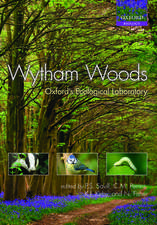Species at Risk Research in Australia: Proceedings of a Symposium on the Biology of Rare and Endangered Species in Australia, sponsored by the Australian Academy of Science and held in Canberra, 25 and 26 November 1981
Editat de R. H. Groves, W. D. L. Rideen Limba Engleză Paperback – 26 dec 2011
Preț: 638.57 lei
Preț vechi: 751.25 lei
-15% Nou
Puncte Express: 958
Preț estimativ în valută:
122.19€ • 133.14$ • 102.96£
122.19€ • 133.14$ • 102.96£
Carte tipărită la comandă
Livrare economică 23 aprilie-07 mai
Preluare comenzi: 021 569.72.76
Specificații
ISBN-13: 9783642685248
ISBN-10: 3642685242
Pagini: 228
Ilustrații: VI, 216 p.
Dimensiuni: 170 x 244 x 12 mm
Greutate: 0.37 kg
Ediția:Softcover reprint of the original 1st ed. 1982
Editura: Springer Berlin, Heidelberg
Colecția Springer
Locul publicării:Berlin, Heidelberg, Germany
ISBN-10: 3642685242
Pagini: 228
Ilustrații: VI, 216 p.
Dimensiuni: 170 x 244 x 12 mm
Greutate: 0.37 kg
Ediția:Softcover reprint of the original 1st ed. 1982
Editura: Springer Berlin, Heidelberg
Colecția Springer
Locul publicării:Berlin, Heidelberg, Germany
Public țintă
ResearchDescriere
Evolutionary progress has long been associated with the extinction of species. So why should we be concerned now, even when the number of species at risk is substantial, such as one tenth of the Australian flora? The reasons for concern are many stranded. Compassion is one strand. Remember the instructions to Noah: 'And you shall bring living creatures of every kind into the ark and keep them alive with you'. Guilt may be another strand, that our hunting, clearing, collecting, pollution, introduction of competitors and other human activities may have endangered species such as the Orange-bellied Parrot. Nostalgia for what was and concern for what might be also play a part; species at risk include some which are of immediate use, such as the whales, and many of potential use, whether drug plants in the forests of the Amazon or a wild relative of the soybean in Victoria. Aesthetic considerations are also involved, particularly where colourful birds or unusual flowers are threatened. We cherish diversity, as culturally desirable, and are delighted when supposedly extinct species such as the notornis and coelacanth - and maybe yet the thylacine - are rediscovered. The Loch Ness monster has already been blessed with a Latin binomial in anticipation! Diversity is also of ecological as well as of cultural value, contributing to the stability of ecosystems, as in the case of insects and birds which fertilize the flowers and disperse the seeds of plants.
Cuprins
Introductory Papers.- What species, what risk?.- The conservation status of Australian plants.- The conservation status of Australian mammals.- Case Histories.- Eucalyptus caesia, a rare maIlee of granite rocks from south-western Australia.- The relevance of genetic systems in Isotoma petraea to conservation practice.- Isolation, introgression and genetic variation in rock-wallabies.- Rare plants of the Victorian plains.- The Orange-bellied Parrot.- The Noisy Scrubbird in Western Australia.- Leadbeaters Possum and its management.- The Koala : little fact, much emotion.- Overviews.- The role of conservation genetics in the conservation of rare species.- Rare species: precious or dross?.- Changing directions in research on Australian rare plants.- Towards informed management.- Appendix 1.- Appendix 2.











